Flood Hazard Risk Mapping Using a Pseudo Supervised Random Forest
Abstract
1. Introduction
2. Materials and Methods
2.1. Study Areas
2.2. Datasets
2.3. Conditioning Factors
2.4. HAND Model
2.5. Random Forest
2.6. Pseudo Supervised Random Forest (PS-RF)
3. Results
4. Discussion
5. Conclusions
Author Contributions
Funding
Acknowledgments
Conflicts of Interest
References
- Tehrany, M.S.; Lee, M.-J.; Pradhan, B.; Jebur, M.N.; Lee, S. Flood susceptibility mapping using integrated bivariate and multivariate statistical models. Environ. Earth Sci. 2014, 72, 4001–4015. [Google Scholar] [CrossRef]
- Thistlethwaite, J.; Henstra, D.; Brown, C.; Scott, D. How flood experience and risk perception influences protective actions and behaviours among Canadian homeowners. Environ. Manag. 2018, 61, 197–208. [Google Scholar] [CrossRef]
- Messner, F.; Meyer, V. Flood damage, vulnerability and risk perception–challenges for flood damage research. In Flood Risk Management: Hazards, Vulnerability and Mitigation Measures; Springer: Berlin/Heidelberg Germany, 2006; pp. 149–167. [Google Scholar]
- Ghoneim, E.; Foody, G.M. Assessing flash flood hazard in an arid mountainous region. Arab. J. Geosci. 2013, 6, 1191–1202. [Google Scholar] [CrossRef]
- Nicholls, R.; Burcharth, H.F.; Zanuttigh, B.; Andersen, T.L.; Orcid, L.; Lara, J.L.; Steendam, G.j.; Roul, P.; Sergent, P.; Ostrowski, R.; et al. Developing a holistic approach to assessing and managing coastal flood risk. In Coastal Risk Management in a Changing Climate; Elsevier—Butterworth-Heinemann: Oxford, UK, 2015; pp. 9–53. [Google Scholar]
- Gaur, A.; Gaur, A.; Simonovic, S.P. Future Changes in Flood Hazards across Canada under a Changing Climate. Water 2018, 10, 1441. [Google Scholar] [CrossRef]
- Schiermeier, Q. Increased flood risk linked to global warming: Likelihood of extreme rainfall may have been doubled by rising greenhouse-gas levels. Nature 2011, 470, 316–317. [Google Scholar] [CrossRef] [PubMed]
- Brunner. HEC-RES River Analysis System—User’s Manual Version 5.0. US Army Corps of Engineers; Institute for Water Resources, Hydrologic Engineering Center (HEC): Davis, CA, USA, 2016; p. 962. [Google Scholar]
- DHI. MIKE 11—A Modelling System for Rivers and Channels—User Guide; DHI: Hørsholm, Denmark, 2003; p. 430. [Google Scholar]
- DHI. MIKE 21-2D Modelling of Coast and Sea; DHI Water & Environment Pty Ltd.: Hørsholm, Denmark, 2012. [Google Scholar]
- Moulinec, C.; Denis, C.; Pham, C.-T.; Rougé, D.; Razafindrakoto, J.-M.; Razafindrakoto, E.; Barber, R.W.; Emerson, D.R.; Gu, X.-J. TELEMAC: An efficient hydrodynamics suite for massively parallel architectures. Comput. Fluids 2011, 51, 30–34. [Google Scholar] [CrossRef]
- Prakash, M.; Rothauge, K.; Cleary, P.W. Modelling the impact of dam failure scenarios on flood inundation using SPH. Appl. Math. Model. 2014, 38, 5515–5534. [Google Scholar] [CrossRef]
- Vacondio, R.; Rogers, B.D.; Stansby, P.K.; Mignosa, P. SPH modeling of shallow flow with open boundaries for practical flood simulation. J. Hydraul. Eng. 2012, 138, 530–541. [Google Scholar] [CrossRef]
- Smith, L.C. Satellite remote sensing of river inundation area, stage, and discharge: A review. Hydrol. Process. 1997, 11, 1427–1439. [Google Scholar] [CrossRef]
- Schumann, G.; Bates, D.P.; Horritt, S.M.; Matgen, P.; Pappenberger, F. Progress in integration of remote sensing-derived flood extent and stage data and hydraulic models. Rev. Geophys. 2009, 47. [Google Scholar] [CrossRef]
- Lhomme, J.; Sayers, P.; Gouldby, B.; Samuels, P.; Wills, M.; Mulet-Marti, J. Recent development and application of a rapid flood spreading method. In Proceedings of the FLOODrisk, Keble College, Oxford, UK, 30 September–2 October 2008. [Google Scholar]
- Nobre, A.D.; Nobre, A.D.; Cuartas, L.A.; Hodnett, M.; Rennó, C.D.; Rodrigues, G.; Silveira, A.; Saleska, S. Height Above the Nearest Drainage—A hydrologically relevant new terrain model. J. Hydrol. 2011, 404, 13–29. [Google Scholar] [CrossRef]
- Tehrany, M.S.; Pradhan, B.; Jebur, M.N. Flood susceptibility mapping using a novel ensemble weights-of-evidence and support vector machine models in GIS. J. Hydrol. 2014, 512, 332–343. [Google Scholar] [CrossRef]
- Rahmati, O.; Pourghasemi, H.R.; Melesse, A.M. Application of GIS-based data driven random forest and maximum entropy models for groundwater potential mapping: A case study at Mehran Region, Iran. Catena 2016, 137, 360–372. [Google Scholar] [CrossRef]
- Zhao, G.; Pang, B.; Xu, Z.; Peng, D.; Xu, L. Assessment of urban flood susceptibility using semi-supervised machine learning model. Sci. Total Environ. 2019, 659, 940–949. [Google Scholar] [CrossRef] [PubMed]
- Pourghasemi, H.R.; Kariminejad, N.; Amiri, M.; Edalat, M.; Zarafshar, M.; Blaschke, T.; Cerda, A. Assessing and Mapping Multi-Hazard Risk Susceptibility Using a Machine Learning Technique|Scientific Reports. 2020. Available online: https://www.nature.com/articles/s41598-020-60191-3 (accessed on 30 April 2020).
- Teng, J.; Jakeman, A.J.; Vaze, J.; Croke, B.F.; Dutta, D.; Kim, S. Flood inundation modelling: A review of methods, recent advances and uncertainty analysis. Environ. Model. Softw. 2017, 90, 201–216. [Google Scholar] [CrossRef]
- Brunner, G.W.; Piper, S.S.; Jensen, M.R.; Chacon, B. Combined 1D and 2D hydraulic modeling within HEC-RAS. In World Environmental and Water Resources Congress; ASCE: Austin, TX, USA, 2015; pp. 1432–1443. [Google Scholar]
- Monaghan, J.J. Simulating free surface flows with SPH. J. Comput. Phys. 1994, 110, 399–406. [Google Scholar] [CrossRef]
- Ye, J.; McCorquodale, J.A. Simulation of curved open channel flows by 3D hydrodynamic model. J. Hydraul. Eng. 1998, 124, 687–698. [Google Scholar] [CrossRef]
- Sidrane, C.; Fitzpatrick, D.J.; Annex, A.; O’Donoghue, D.; Gal, Y.; Biliński, P. Machine Learning for Generalizable Prediction of Flood Susceptibility. arXiv 2019, arXiv:1910.06521. [Google Scholar]
- Rennó, C.D.; Nobre, A.D.; Cuartas, L.A.; Soares, J.V.; Hodnett, M.G.; Tomasella, J. HAND, a new terrain descriptor using SRTM-DEM: Mapping terra-firme rainforest environments in Amazonia. Remote Sens. Environ. 2008, 112, 3469–3481. [Google Scholar] [CrossRef]
- Momo, M.R. Evaluation of the Application of the HAND model in Mapping of Areas Susceptible to Flooding in the Municipality of Blumenau. Ph.D. Thesis, Tese de Mestrado em Engenharia Ambiental, Fundação Universidade Regional de, Blumenau, Brazil, 2014. (In Spanish). [Google Scholar]
- McGrath, H.; Bourgon, J.-F.; Proulx-Bourque, J.-S.; Nastev, M.; el Ezz, A.A. A comparison of simplified conceptual models for rapid web-based flood inundation mapping. Nat. Hazards 2018, 93, 905–920. [Google Scholar] [CrossRef]
- Nobre, A.D.; Cuartas, L.A.; Momo, M.R.; Severo, D.L.; Pinheiro, A.; Nobre, C.A. HAND contour: A new proxy predictor of inundation extent. Hydrol. Process. 2016, 30, 320–333. [Google Scholar] [CrossRef]
- Toth, E.; Brath, A.; Montanari, A. Comparison of short-term rainfall prediction models for real-time flood forecasting. J. Hydrol. 2000, 239, 132–147. [Google Scholar] [CrossRef]
- Falah, F.; Rahmati, O.; Rostami, M.; Ahmadisharaf, E.; Daliakopoulos, I.N.; Pourghasemi, H.R. Artificial neural networks for flood susceptibility mapping in data-scarce urban areas. In Spatial Modeling in GIS and R for Earth and Environmental Sciences; Elsevier: Amsterdam, The Netherlands, 2019; pp. 323–336. [Google Scholar]
- Tehrany, M.S.; Pradhan, B.; Mansor, S.; Ahmad, N. Flood susceptibility assessment using GIS-based support vector machine model with different kernel types. Catena 2015, 125, 91–101. [Google Scholar] [CrossRef]
- Tehrany, M.S.; Pradhan, B.; Jebur, M.N. Flood susceptibility analysis and its verification using a novel ensemble support vector machine and frequency ratio method. Stoch. Environ. Res. A Risk Assess. 2015, 29, 1149–1165. [Google Scholar] [CrossRef]
- Lee, S.; Kim, J.-C.; Jung, H.-S.; Lee, M.J.; Lee, S. Spatial prediction of flood susceptibility using random-forest and boosted-tree models in Seoul metropolitan city, Korea. Geomat. Nat. Hazards Risk 2017, 8, 1185–1203. [Google Scholar] [CrossRef]
- Zhao, G.; Pang, B.; Xu, Z.; Yue, J.; Tu, T. Mapping flood susceptibility in mountainous areas on a national scale in China. Sci. Total Environ. 2018, 615, 1133–1142. [Google Scholar] [CrossRef]
- Khu, S.T.; Liong, S.-Y.; Babovic, V.; Madsen, H.; Muttil, N. Genetic programming and its application in real-time runoff forecasting 1. JAWRA J. Am. Water Resour. Assoc. 2001, 37, 439–451. [Google Scholar] [CrossRef]
- Rahmati, O.; Pourghasemi, H.R.; Zeinivand, H. Flood susceptibility mapping using frequency ratio and weights-of-evidence models in the Golastan Province, Iran. Geocarto Int. 2016, 31, 42–70. [Google Scholar] [CrossRef]
- Khosravi, K.; Nohani, E.; Maroufinia, E.; Pourghasemi, H.R. A GIS-based flood susceptibility assessment and its mapping in Iran: A comparison between frequency ratio and weights-of-evidence bivariate statistical models with multi-criteria decision-making technique. Nat. Hazards 2016, 83, 947–987. [Google Scholar] [CrossRef]
- Pradhan, B. Flood susceptible mapping and risk area delineation using logistic regression, GIS and remote sensing. J. Spat. Hydrol. 2010, 9, 1–18. [Google Scholar]
- Tehrany, M.S.; Pradhan, B.; Jebur, M.N. Spatial prediction of flood susceptible areas using rule based decision tree (DT) and a novel ensemble bivariate and multivariate statistical models in GIS. J. Hydrol. 2013, 504, 69–79. [Google Scholar] [CrossRef]
- Haq, M.; Akhtar, M.; Muhammad, S.; Paras, S.; Rahmatullah, J. Techniques of Remote Sensing and GIS for flood monitoring and damage assessment: A case study of Sindh province, Pakistan. Egypt. J. Remote Sens. Space Sci. 2012, 15, 135–141. [Google Scholar] [CrossRef]
- Pradhan, B.; Hagemann, U.; Tehrany, M.S.; Prechtel, N. An easy to use ArcMap based texture analysis program for extraction of flooded areas from TerraSAR-X satellite image. Comput. Geosci. 2014, 63, 34–43. [Google Scholar] [CrossRef]
- Esfandiari, M.; Jabari, S.; McGrath, H.; Coleman, D. Flood mapping using Random Forest and Identifying the essential conditioning factors; A case study in Fredericton, New Brunswick, Canada. ISPRS Ann. Photogramm. Remote Sens. Spat. Inf. Sci. 2020, 3, 609–615. [Google Scholar] [CrossRef]
- Lee, D.-H. Pseudo-label: The simple and efficient semi-supervised learning method for deep neural networks. In Workshop on Challenges in Representation Learning, ICML; Kaggle: San Francisco, CA, USA, 2013; Volume 3. [Google Scholar]
- Fischler, M.a.; Bolles, R.C. Random sample consensus: A paradigm for model fitting with. Commun. ACM 1981, 24, 381–395. [Google Scholar] [CrossRef]
- McGrath, H.; Stefanakis, E.; Nastev, M. Rapid risk evaluation (ER 2) using MS excel spreadsheet: A case study of Fredericton (New Brunswick, Canada). ISPRS Ann. Photogramm. Remote Sens. Spat. Inf. Sci. 2016, 3, 27. [Google Scholar] [CrossRef]
- Ottawa Riverkeeper’s River Report, Ecology and Impacts. 2006. Available online: https://www.ottawariverkeeper.ca/wp-content/uploads/2018/01/River-Report-English.pdf.pdf (accessed on 10 June 2020).
- ET|Last Updated: May 4, and 2019, Under Water, again|CBC News. CBC. 4 May 2019. Available online: https://www.cbc.ca/news/canada/ottawa/ottawa-river-flooding-2019-recap-1.5119980 (accessed on 10 June 2020).
- AT|Last Updated: April 30, and 2018, Worst Floods in New Brunswick History: How 2018 Compares|CBC News. CBC. 30 April 2018. Available online: https://www.cbc.ca/news/canada/new-brunswick/st-john-river-flooding-history-1.4641969 (accessed on 7 May 2020).
- Fathollahi, F.; Zhang, Y. Adaptive band selection for pan-sharpening of hyperspectral images. Int. J. Remote Sens. 2020, 41, 3924–3947. [Google Scholar] [CrossRef]
- Jabari, S.; Fathollahi, F.; Roshan, A.; Zhang, Y. Improving UAV imaging quality by optical sensor fusion: An initial study. Int. J. Remote Sens. 2017, 38, 4931–4953. [Google Scholar] [CrossRef]
- Zhang, Y. Understanding image fusion. Photogramm. Eng. Remote Sens. 2004, 70, 657–661. [Google Scholar]
- Amer, R.; Kolker, A.S.; Muscietta, A. Propensity for erosion and deposition in a deltaic wetland complex: Implications for river management and coastal restoration. Remote Sens. Environ. 2017, 199, 39–50. [Google Scholar] [CrossRef]
- Congedo, L. Semi-automatic classification plugin documentation. Release 2016, 4, 29. [Google Scholar]
- New Brunswick Geographic Database. Available online: http://www.snb.ca/geonb1/e/DC/catalogue-E.asp (accessed on 10 June 2020).
- ERD 2015 Lidar. Available online: https://geonb.snb.ca/downloads2/lidar/2015/erd/meta/erd2015.html (accessed on 24 June2020).
- Secretariat, T.B.C.; Secretariat, T.B.C. High Resolution Digital Elevation Model (HRDEM)—CanElevation Series—Open Government Portal. Available online: https://open.canada.ca/data/en/dataset/957782bf-847c-4644-a757-e383c0057995 (accessed on 11 June 2020).
- Kia, M.B.; Pirasteh, S.; Pradhan, B.; Mahmud, A.R.; Sulaiman, W.N.A.; Moradi, A. An artificial neural network model for flood simulation using GIS: Johor River Basin, Malaysia. Environ. Earth Sci. 2012, 67, 251–264. [Google Scholar] [CrossRef]
- Tehrany, M.S.; Jones, S.; Shabani, F. Identifying the essential flood conditioning factors for flood prone area mapping using machine learning techniques. Catena 2019, 175, 174–192. [Google Scholar] [CrossRef]
- Agriculture and Agri-Food Canada. Available online: https://www.agr.gc.ca/atlas/aci/ (accessed on 10 June 2020).
- Ihsan, Z.; Idris, M.Y.; Abdullah, A.H. Attribute normalization techniques and performance of intrusion classifiers: A comparative analysis. Life Sci. J. 2013, 10, 2568–2576. [Google Scholar]
- Speckhann, G.A.; Chaffe, P.L.B.; Goerl, R.F.; de Abreu, J.J.; Flores, J.A.A. Flood hazard mapping in Southern Brazil: A combination of flow frequency analysis and the HAND model. Hydrol. Sci. J. 2018, 63, 87–100. [Google Scholar] [CrossRef]
- Chow, C.; Twele, A.; Martinis, S. An assessment of the Height above Nearest Drainage terrain descriptor for the thematic enhancement of automatic SAR-based flood monitoring services. In Remote Sensing for Agriculture, Ecosystems, and Hydrology XVIII; International Society for Optics and Photonics: Bellingham, WA, USA, 2016; Volume 9998, p. 999808. [Google Scholar]
- Tarboton, D.G.; Sazib, N.; Dash, P. TauDEM 5.3 Quick Start Guide to Using the TauDEM, ArcGIS, Toolbox; Utah State University: Logan, UT, USA, 2015. [Google Scholar]
- Tarboton, D.G. A new method for the determination of flow directions and upslope areas in grid digital elevation models. Water Resour. Res. 1997, 33, 309–319. [Google Scholar] [CrossRef]
- Liu, Y.Y.; Maidment, R.D.; Tarboton, G.D.; Zheng, X.; Yildirim, A.; Sazib, S.N.; Wang, S. A CyberGIS approach to generating high-resolution height above nearest drainage (HAND) raster for national flood mapping. In Proceedings of the Third International Conference of CyberGIS and Geospatial Data Science, Urbana, IL, USA, 26–28 July 2016. [Google Scholar]
- Ottawa Open Data. Available online: https://ottawa.ca/en/city-hall/get-know-your-city/open-data (accessed on 10 June 2020).
- Liu, Y.Y.; Maidment, D.R.; Tarboton, D.G.; Zheng, X.; Wang, S.A. CyberGIS integration and computation framework for high-resolution continental-scale flood inundation mapping. JAWRA J. Am. Water Resour. Assoc. 2018, 54, 770–784. [Google Scholar] [CrossRef]
- Breiman, L. Random forests. Mach. Learn. 2001, 45, 5–32. [Google Scholar] [CrossRef]
- Rahmati, O.; Pourghasemi, H.R. Identification of critical flood prone areas in data-scarce and ungauged regions: A comparison of three data mining models. Water Resour. Manag. 2017, 31, 1473–1487. [Google Scholar] [CrossRef]
- Pedregosa, F.; Varoquaux, G.; Gramfort, A.; Michel, V.; Thirion, B.; Grisel, O.; Blondel, M.; Prettenhofer, P.; Weiss, R.; Dubourg, V.; et al. Scikit-learn: Machine learning in Python. J. Mach. Learn. Res. 2011, 12, 2825–2830. [Google Scholar]
- Campbell, J.B.; Wynne, R.H. Introduction to Remote Sensing; Guilford Press: New York, NY, USA, 2011. [Google Scholar]
- Matthews, B.W. Comparison of the predicted and observed secondary structure of T4 phage lysozyme. Biochim. Biophys. Acta BBA Protein Struct. 1975, 405, 442–451. [Google Scholar] [CrossRef]
- McHugh, M.L. Interrater reliability: The kappa statistic. Biochem. Med. Biochem. Med. 2012, 22, 276–282. [Google Scholar] [CrossRef]
- Delgado, R.; Tibau, X.-A. Why Cohen’s Kappa should be avoided as performance measure in classification. PLoS ONE 2019, 14, e0222916. [Google Scholar] [CrossRef] [PubMed]


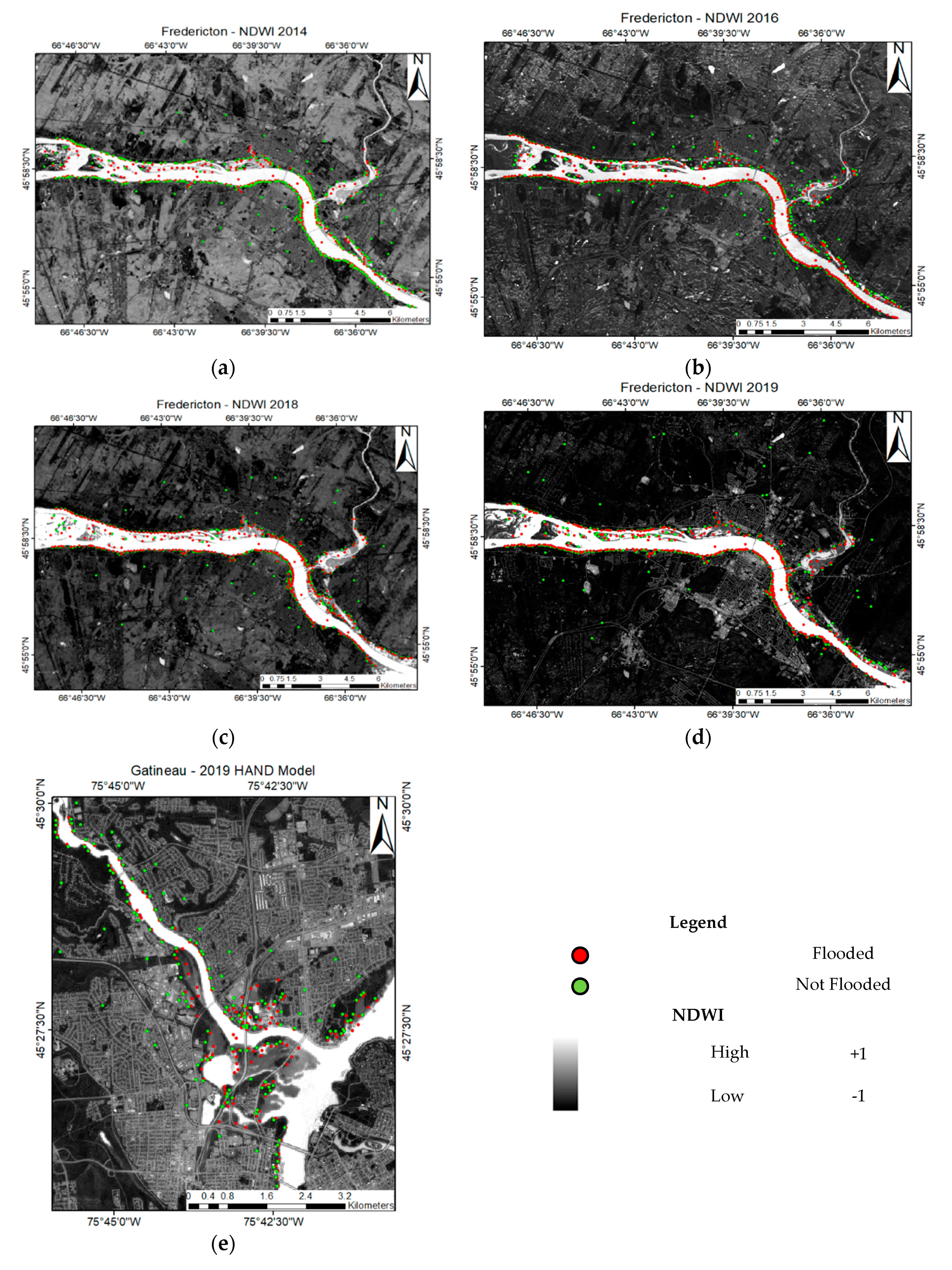

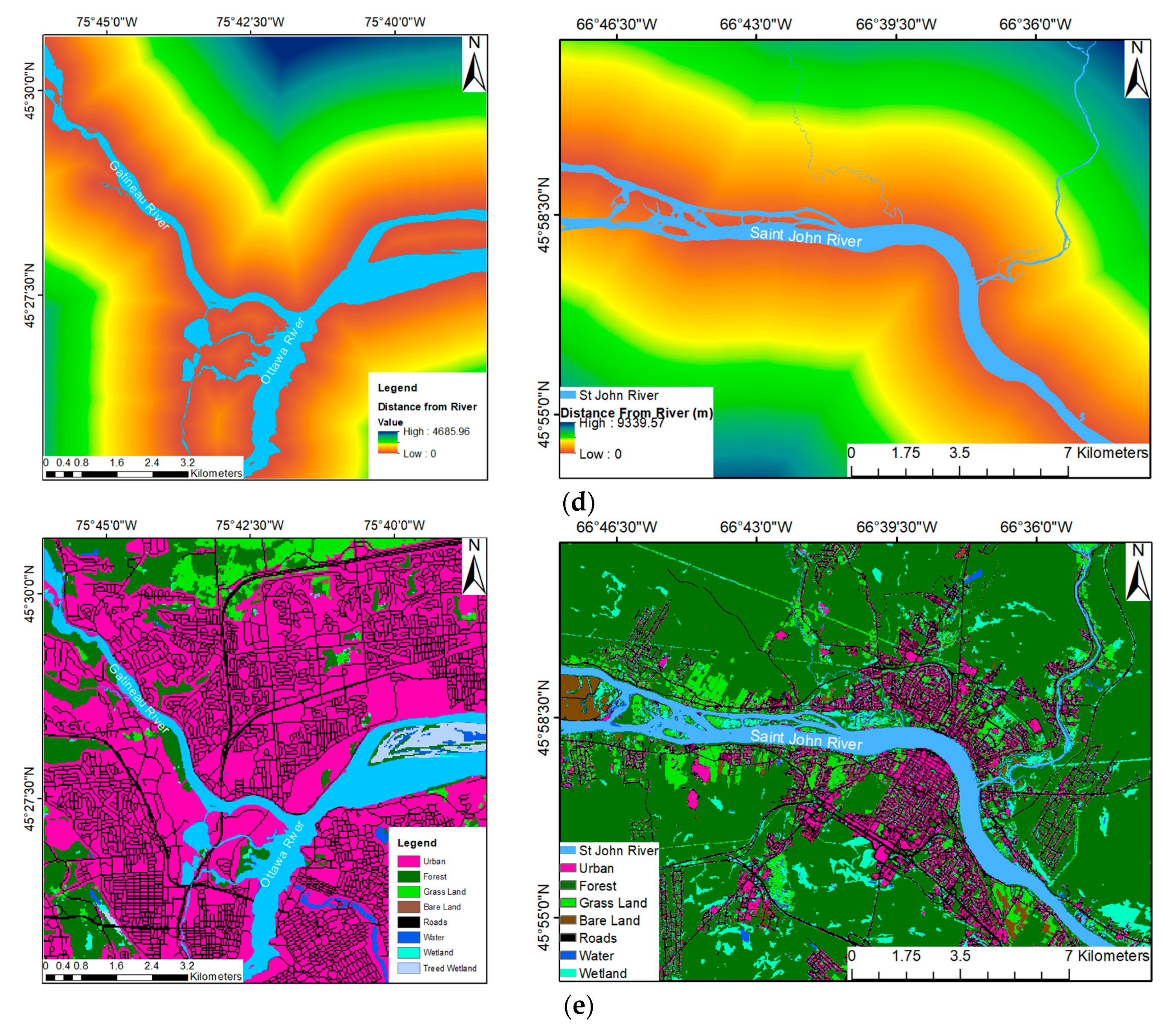

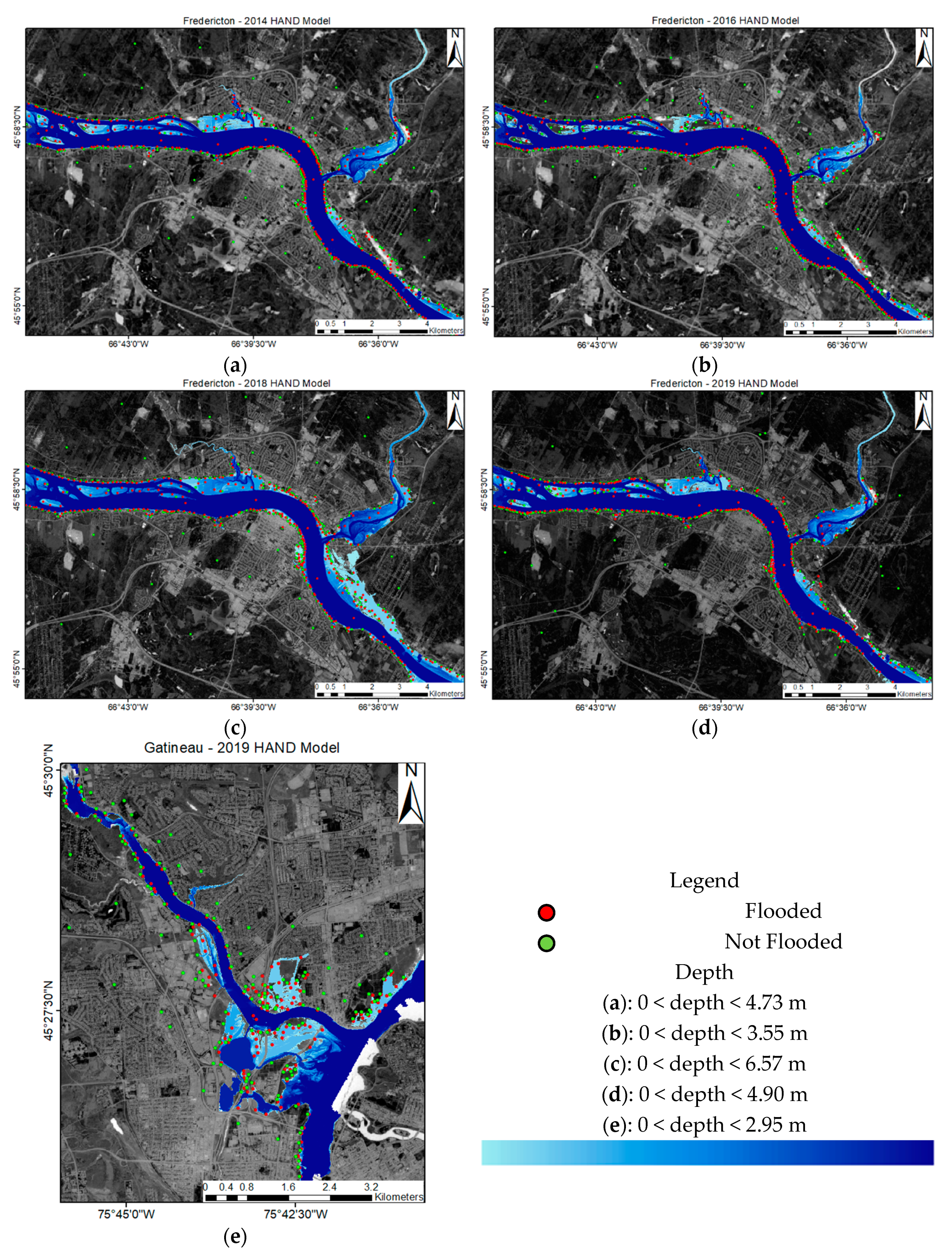
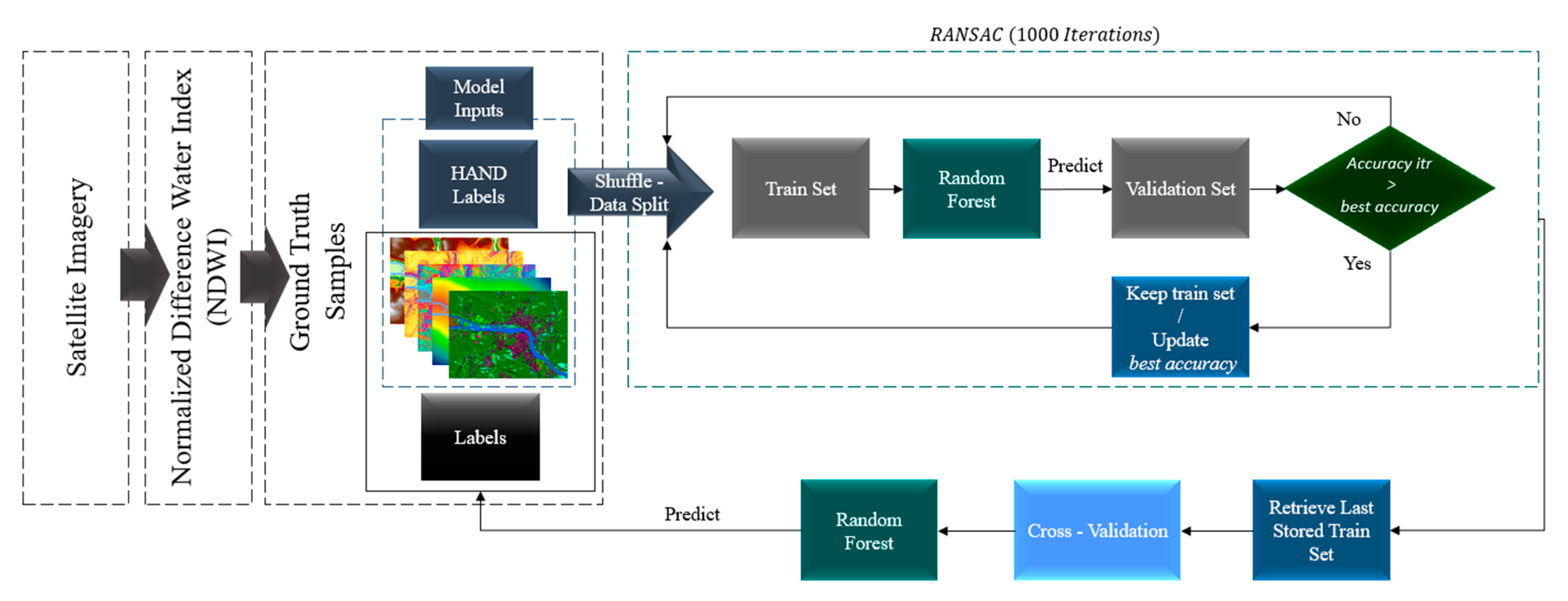
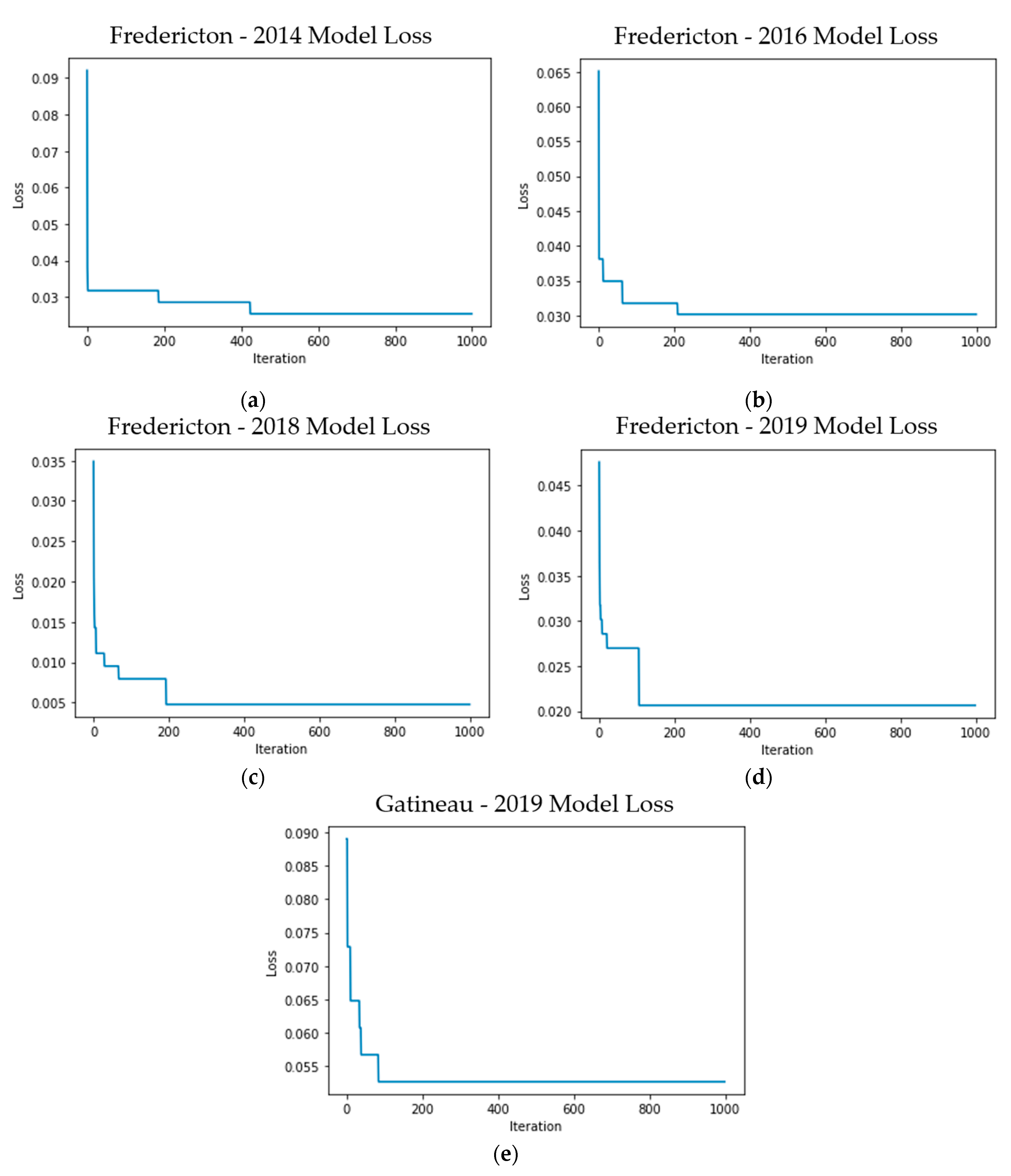
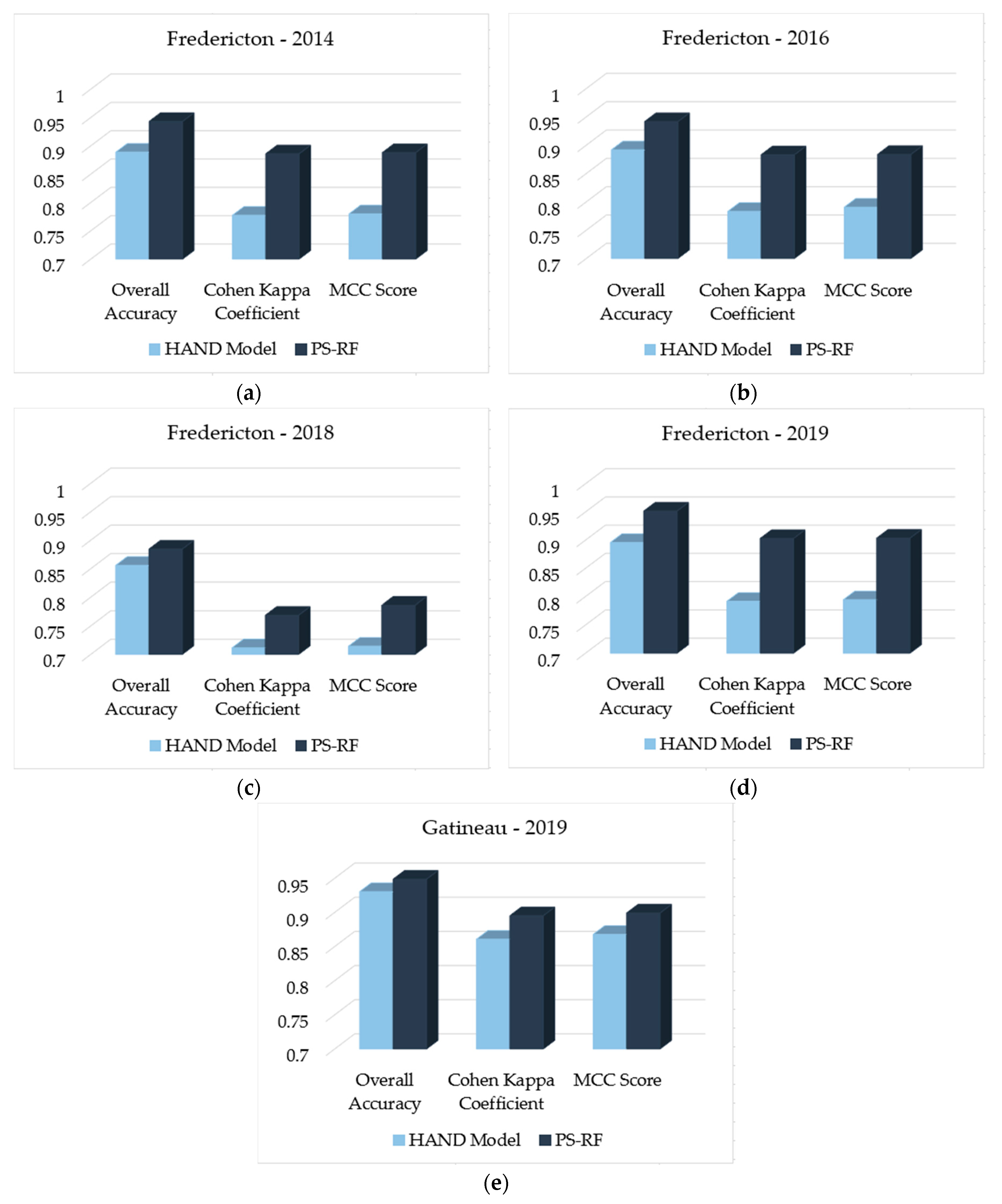


| Flood Event | Satellite | Spatial Resolution | Time of Imagery | Water Depth |
|---|---|---|---|---|
| Fredericton 2014 | Landsat-8 | 15-m (Pansharpened) | 7 May 2014—15:12:54 | 6.19 m |
| Fredericton 2016 | Landsat-8 | 15-m (Pansharpened) | 10 April 2016—15:12:54 | 5.02 m |
| Fredericton 2018 | Sentinel-2 | 10-m | 2 May 2018—15:26:00 | 8.04 m |
| Fredericton 2019 | Sentinel-2 | 10-m | 2 May 2019—15:26:39 | 6.37 m |
| Gatineau 2019 | Sentinel-2 | 10-m | 6 May 2019—15:49:11 | 44.99 m |
| Parameter Name | Formula | |
|---|---|---|
| Sensitivity (TPR) | (2) | |
| Specificity (TNR) | (3) | |
| Fall-out (FPR) | (4) | |
| Miss-rate (FNR) | (5) | |
| Overall Accuracy | (6) | |
| Cohen’s Kappa Coefficient (K) | (7) | |
| Matthews Correlation Coefficient (MCC) | (8) |
© 2020 by the authors. Licensee MDPI, Basel, Switzerland. This article is an open access article distributed under the terms and conditions of the Creative Commons Attribution (CC BY) license (http://creativecommons.org/licenses/by/4.0/).
Share and Cite
Esfandiari, M.; Abdi, G.; Jabari, S.; McGrath, H.; Coleman, D. Flood Hazard Risk Mapping Using a Pseudo Supervised Random Forest. Remote Sens. 2020, 12, 3206. https://doi.org/10.3390/rs12193206
Esfandiari M, Abdi G, Jabari S, McGrath H, Coleman D. Flood Hazard Risk Mapping Using a Pseudo Supervised Random Forest. Remote Sensing. 2020; 12(19):3206. https://doi.org/10.3390/rs12193206
Chicago/Turabian StyleEsfandiari, Morteza, Ghasem Abdi, Shabnam Jabari, Heather McGrath, and David Coleman. 2020. "Flood Hazard Risk Mapping Using a Pseudo Supervised Random Forest" Remote Sensing 12, no. 19: 3206. https://doi.org/10.3390/rs12193206
APA StyleEsfandiari, M., Abdi, G., Jabari, S., McGrath, H., & Coleman, D. (2020). Flood Hazard Risk Mapping Using a Pseudo Supervised Random Forest. Remote Sensing, 12(19), 3206. https://doi.org/10.3390/rs12193206






